神社の前に立つ、あの象徴的な門、鳥居。私たちは当たり前のようにその存在を受け入れていますが、その起源や意味、そして驚くほど多様な形については、意外と知られていないことが多いのではないでしょうか。鳥居は単なるゲートではありません。それは、神聖な世界と私たちの住む俗世とを分ける結界であり、日本の精神文化を深く映し出す鏡でもあるのです。なぜあの形なのか、なぜ朱色が多いのか、その謎を紐解く旅に出かけましょう。
- 聖と俗を分かつ結界: 鳥居が持つ、単なる「門」以上の宗教的な役割とその空間的な意味。
- デザインに秘められた神々の物語: 直線的な「神明鳥居」と曲線的な「明神鳥居」、二大系統から辿る鳥居の様式美とその進化。
- 朱だけではない色彩のシンフォニー: 朱色が持つ魔除けの意味から、白木や黒木が語りかける神社の個性と自然観。
神域への神聖なるゲートウェイ
神社の参道を進むと、まず私たちを迎えてくれるのが鳥居です。この鳥居をくぐるという行為は、単に境内に入ること以上の意味を持っています。それは、私たちが住む日常の世界(俗界)から、神々が鎮座する神聖な領域(神域)へと足を踏み入れるための、意識的な境界越えの儀式なのです。鳥居をくぐる際に一礼するのは、これから神聖な場所にお邪魔します、という敬意の表明に他なりません。
この結界としての役割は、鳥居の起源に関する説にも繋がっています。一説には、日本神話で天照大御神が天岩戸に隠れた際、神々が鳥(常世長鳴鳥)を止まり木に止まらせて鳴かせたところ、大御神が再び姿を現したという物語に由来すると言われています。この「鳥が居た木」が鳥居の原型になったというのです。この説は、鳥が神の使い、あるいは神意を告げる存在と見なされていた古代の信仰を反映しているのかもしれません。
多様な形が語る神社の個性
一言で鳥居と言っても、そのデザインは実に様々です。しかし、その多様な鳥居も、大きく分けると二つの系統に分類することができます。それが「神明(しんめい)鳥居」と「明神(みょうじん)鳥居」です。
神明鳥居は、直線的で素朴、かつ原始的な形態を特徴としています。一番上の横木である「笠木(かさぎ)」は直線で、その下に一本の「貫(ぬき)」が柱を繋いでいます。伊勢神宮の鳥居がその代表例であり、古代からの素朴な信仰の形を今に伝えています。
一方、明神鳥居は、より装飾的で曲線的なデザインが特徴です。笠木が優雅に反り上がり、その下には「島木(しまぎ)」というもう一本の横木が加わります。また、神社名が書かれた「額束(がくづか)」が中央に置かれることも多く、私たちが一般的に「鳥居」と聞いて思い浮かべるのは、この明神鳥居の系統であることが多いでしょう。この様式の発展には、仏教建築の影響も見て取れます。
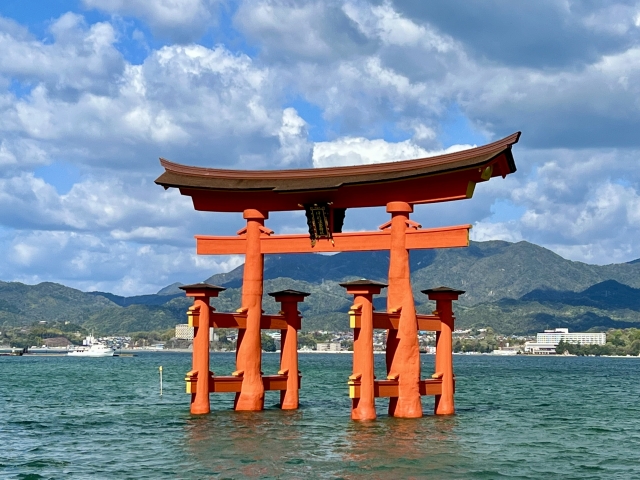
色彩に込められた祈りと願い
鳥居の色といえば、鮮やかな朱色を思い浮かべる人が多いでしょう。特に京都の伏見稲荷大社に見られる千本鳥居の連なりは圧巻です。この朱色は、古来より魔除けの色、そして生命の躍動を象徴する色とされてきました。朱の顔料である辰砂(しんしゃ)が防腐剤としても利用されたことから、木造の鳥居を長持ちさせるという実用的な意味合いもあったと言われています。
しかし、全ての鳥居が朱色というわけではありません。伊勢神宮や出雲大社のように、木材そのものの色を生かした「白木鳥居」は、自然との一体感を重んじる神社の姿勢を示しています。また、京都の野宮神社では、樹皮がついたままのクヌギの木を使った日本最古の様式とされる「黒木鳥居」を見ることができ、その姿は古代の祭祀のあり方を静かに物語っています。
これからの鳥居との向き合い方
日本全国に存在する鳥居は、その土地の信仰や歴史、文化を映し出す貴重なシンボルです。一つ一つの鳥居の形や色の違いに目を向けることで、その神社がどのような神様を祀り、どのような歴史を歩んできたのかを垣間見ることができます。次に神社を訪れる際は、ただ通り過ぎるだけでなく、鳥居の前で少し立ち止まり、その佇まいをじっくりと観察してみてはいかがでしょうか。そこには、日本の豊かな精神文化へと繋がる、新たな発見が待っているはずです。
解説ポイント①:聖と俗を分かつ結界
鳥居の最も本質的な役割は、神聖な空間と日常的な空間を区別する「結界」として機能することです。物理的な門であると同時に、精神的な境界線としての意味合いが非常に強いと言えます。参拝者が鳥居をくぐる際に一礼するのは、この境界を認識し、神域への敬意を示すための作法です。大きな神社では参道に複数の鳥居が建てられていることがあり、一番外側から「一の鳥居、二の鳥居…」と呼ばれます。これは、聖域の中心に近づくにつれて、段階的に神聖さが高まっていくことを示唆しています。この空間構成は、参拝者の心を俗世から切り離し、神と向き合うための準備を促す効果も持っています。
解説ポイント②:デザインに秘められた神々の物語
鳥居のデザインは、大きく「神明(しんめい)系」と「明神(みょうじん)系」に大別されます。
- 神明系鳥居: 全体的に直線的で、装飾が少ないシンプルな構造が特徴です。最上部の横木である笠木(かさぎ)に反りがなく、柱も地面に対して垂直に立てられます。この様式は、日本の神社の古い形態を伝えているとされ、天皇家の祖先神である天照大御神を祀る伊勢神宮に代表されるように、皇室とゆかりの深い神社で多く見られます。その簡素な美しさは、日本の伝統的な美意識である「わび・さび」にも通じるものがあります。
- 明神系鳥居: 笠木に優美な反り(反り増し)があり、その下に島木(しまぎ)という二本目の横木が加わるなど、装飾性が高いのが特徴です。柱が少し傾斜している(ころび)ことも多く、安定感と華やかさを兼ね備えています。全国的に最も広く分布しており、八幡神社や稲荷神社など、多くの神社でこの系統の鳥居が見られます。その発展の背景には、大陸から伝わった仏教建築の華やかな様式が影響したとも考えられています。
この他にも、柱の前後に控柱を持つ「両部鳥居」(厳島神社など)や、三角形の破風がつく「山王鳥居」(日枝神社など)、三つの鳥居を組み合わせた「三柱鳥居」(京都・蚕ノ社)など、多種多様な鳥居が存在し、それぞれが神社の由緒や信仰の形を物語っています。
解説ポイント③:朱だけではない色彩のシンフォニー
鳥居の色には、それぞれ深い意味が込められています。
- 朱色: 最も象徴的な色である朱色は、古くから災厄を防ぐ「魔除け」の色と信じられてきました。また、朱は生命力や活力の象徴でもあり、神の力の高まりを表すとも言われています。特に稲荷神社で朱色の鳥居が多いのは、稲荷大神の持つ豊かな生命力や五穀豊穣の神徳を表しているとされます。
- 白(白木): 塗装を施さず、木材そのものの色を生かした鳥居は、神聖さや清浄さを象徴します。伊勢神宮の鳥居は20年に一度の式年遷宮で新しく建て替えられ、常に清浄な白木であることが保たれています。これは、穢れを嫌い、常に新しく清らかであることを尊ぶ神道の思想を色濃く反映したものです。
- 黒: 京都の野宮神社に見られる「黒木鳥居」は、クヌギの木の皮を剥がずにそのまま組んだ、日本で最も古い様式とされています。その黒々とした姿は、自然そのものへの畏敬の念や、古代の祭祀の素朴で力強い姿を現代に伝えています。
これらの色の違いは、単なるデザイン上の選択ではなく、その神社が何を大切にし、どのような信仰を伝えてきたかを示す、重要なメッセージとなっているのです。
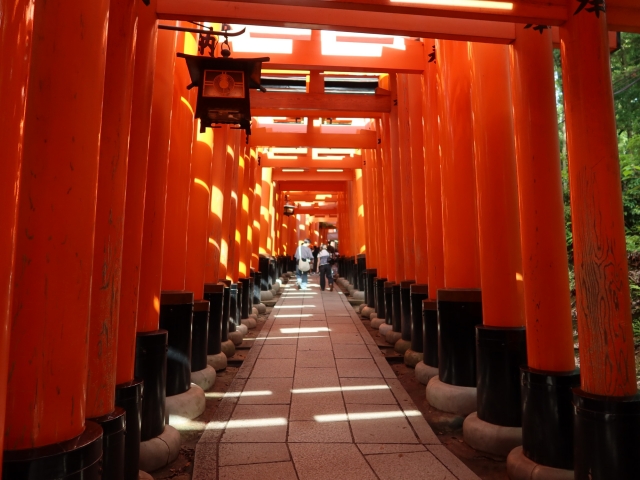
参考文献
- 鳥居 – Wikipedia
- 神社の鳥居ってそもそも何?起源や種類を解説 | 大阪・和歌山のおでかけ情報otent(おてんと)
- 【永久保存版・解説】鳥居の種類、何個いえる?【神社】 – note
- 【全国】鳥居が写真映えする神社11選!千本鳥居や海辺に建つ朱色の鳥居も必見 – じゃらんnet
- 神社の施設(1) – 東京都神社庁
【English Article】
The Secrets of the Torii: More Than Just a Gate to the Sacred World of Japan
Standing before a Shinto shrine, one is always greeted by the iconic gate known as the torii. While it’s a familiar sight, the origins, meanings, and surprising diversity of these structures are often little known. A torii is not merely a gate; it is a sacred boundary separating the divine realm from our mortal world, and a profound reflection of Japan’s spiritual culture. Why this particular shape? Why are so many painted vermilion? Let us embark on a journey to unravel these mysteries.
- A Boundary Between the Sacred and the Profane: The religious role of the torii as more than just a gate, and its significance in defining sacred space.
- Stories of the Gods in Design: Tracing the aesthetic beauty and evolution of torii through its two major styles: the straight-lined Shinmei torii and the curved Myōjin torii.
- A Symphony of Colors Beyond Vermilion: From the demon-warding power of vermilion to the distinct character and view of nature expressed by plain and black wood.
A Sacred Gateway to the Divine Realm
As one proceeds along the path to a shrine, the torii is the first structure to welcome visitors. The act of passing through it signifies more than simply entering the shrine grounds. It is a conscious ritual of crossing the boundary from the everyday world (the profane) into the sacred territory where the gods (kami) reside. The custom of bowing before passing through a torii is an expression of respect, a way of announcing one’s humble visit to this sacred space.
This role as a spiritual boundary is also linked to theories about its origins. One popular theory stems from Japanese mythology, specifically the story of Amaterasu, the sun goddess. When she hid in a heavenly cave, plunging the world into darkness, the other gods perched a rooster (tokoyo no naganakidori) on a roost, whose crowing helped entice her to emerge. It is said that this “bird’s perch” (tori-i) became the prototype for the torii gate. This theory may reflect ancient beliefs in which birds were seen as messengers of the gods.
Diverse Forms Telling a Shrine’s Unique Story
Although we use the single word torii, their designs are incredibly varied. However, this diversity can be broadly classified into two main systems: the Shinmei torii and the Myōjin torii.
The Shinmei torii is characterized by its simple, straight, and primitive form. The top horizontal lintel, the kasagi, is a straight beam, and a single tie beam, the nuki, connects the two pillars. The torii at Ise Grand Shrine is a prime example of this style, conveying the simple form of ancient worship.
In contrast, the Myōjin torii features a more ornate and curvilinear design. The kasagi curves gracefully upwards at the ends, and a second lintel, the shimagi, is placed beneath it. Often, a central plaque, the gakuzuka, bearing the shrine’s name is placed between the beams. This is the style that most people imagine when they think of a torii. The development of this form is believed to have been influenced by Buddhist architecture.
Prayers and Wishes Embodied in Color
When thinking of the color of a torii, many will picture a vibrant vermilion. The rows of thousands of torii at Fushimi Inari Taisha in Kyoto are a particularly breathtaking example. This vermilion hue has long been considered a color that wards off evil and symbolizes the vitality of life. The pigment, derived from cinnabar, also served as a preservative, which had the practical benefit of protecting the wooden structures from decay.
However, not all torii are vermilion. “Unpainted wood torii” (shiraki torii), which showcase the natural color of the wood, like those at Ise Grand Shrine and Izumo Taisha, demonstrate a reverence for unity with nature. Furthermore, at Nonomiya Shrine in Kyoto, one can see a “black wood torii” (kuroki torii), made from cork oak with the bark still intact. This is considered the most ancient style, quietly telling the story of primeval forms of worship.
How to Appreciate Torii from Now On
The torii found all across Japan are precious symbols that reflect the faith, history, and culture of their respective regions. By paying attention to the differences in their shapes and colors, we can catch a glimpse of which deities are enshrined and what history the shrine has passed through. The next time you visit a shrine, why not pause for a moment before its torii instead of just passing through? Take the time to observe its form and presence. New discoveries connecting you to the rich spiritual culture of Japan surely await.
Analysis Point ①: A Boundary Between the Sacred and the Profane
The most fundamental role of a torii is to function as a kekkai, or a spiritual boundary, that separates a sacred space from the mundane world. It is both a physical gate and, more importantly, a symbolic line of demarcation. The act of bowing when passing through is a custom for acknowledging this boundary and showing respect for the divine realm. At larger shrines, it is common to find multiple torii along the main approach, which are numbered “first torii” (ichi no torii), “second torii” (ni no torii), and so on, starting from the outermost one. This suggests a gradual increase in sanctity as one moves closer to the central sanctuary. This spatial design helps visitors to mentally detach from the secular world and prepare themselves to face the kami.
Analysis Point ②: Stories of the Gods in Design
The design of torii can be broadly categorized into the Shinmei and Myōjin styles.
- Shinmei Style: Characterized by its overall straight lines and simple, unadorned structure. The uppermost lintel (kasagi) is straight, and the pillars are typically vertical. This style is believed to preserve the ancient form of Japanese shrines and is often found at shrines with deep connections to the Imperial Family, such as Ise Grand Shrine, which enshrines Amaterasu Omikami, the ancestral goddess of the Imperial House. Its minimalist beauty resonates with the traditional Japanese aesthetic of wabi-sabi.
- Myōjin Style: This style is more decorative, featuring an elegant upward curve (sorimashi) on the kasagi and the addition of a second lintel (shimagi) underneath. The pillars often have a slight inward lean (korobi), giving the structure both stability and a sense of grace. This is the most widespread type of torii in Japan, seen at numerous shrines including Hachiman and Inari shrines. It is thought that the ornate styles of Buddhist architecture, introduced from the continent, influenced its development.
In addition to these two major types, there are many other variations, such as the Ryōbu torii with supporting posts in front of and behind the main pillars (e.g., Itsukushima Shrine), the Sannō torii with a triangular gable on top (e.g., Hie Shrine), and the unique Mihashira torii formed by three interlocking torii (e.g., Konoshima Shrine in Kyoto), each telling the unique history and faith of its shrine.
Analysis Point ③: A Symphony of Colors Beyond Vermilion
The colors of torii are imbued with deep meaning.
- Vermilion: The most iconic color, vermilion, has been believed since ancient times to be a color that “wards off evil” and protects against disaster. It also symbolizes vitality and life force, representing the heightened power of the kami. The reason vermilion torii are particularly common at Inari shrines is said to be that the color represents the abundant life force and agricultural blessings of the deity Inari.
- White (Plain Wood): Unpainted torii that utilize the natural color of the wood symbolize sanctity and purity. At Ise Grand Shrine, the torii are rebuilt every 20 years during the Shikinen Sengu ceremony, ensuring they are always made of clean, new wood. This strongly reflects the Shinto ideal of revering purity and newness while abhorring defilement (kegare).
- Black: The kuroki torii at Nonomiya Shrine in Kyoto, constructed from cork oak wood with the bark left on, is considered the oldest style in Japan. Its dark, rugged appearance conveys a reverence for nature itself and communicates the simple yet powerful character of ancient rituals to the present day.
These color variations are not merely aesthetic choices; they are important messages that signify what each shrine values and the nature of the faith it has passed down through generations.

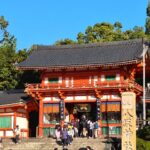
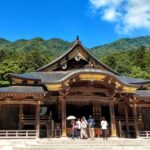


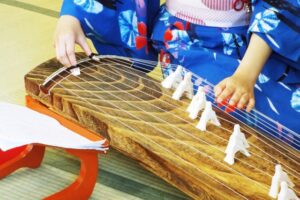

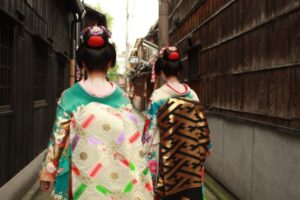
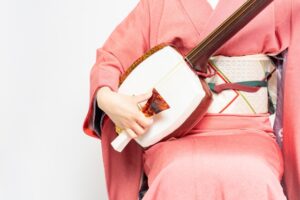

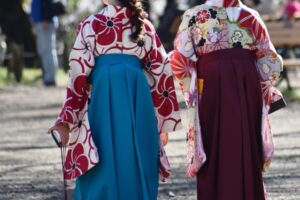
コメントを残す